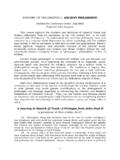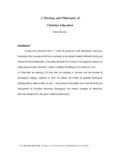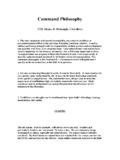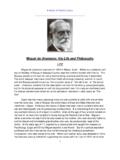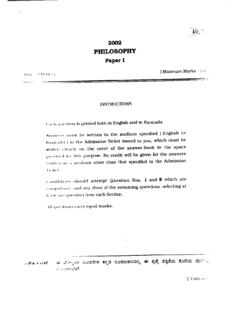Transcription of Chapter 1: An Introduction to Philosophy of Science
1 3 Chapter 1: An Introduction to Philosophy of Science Malcolm Forster, February 24, 2004. General Philosophy of Science According to one definition, a general Philosophy of Science seeks to describe and understand how Science works within a wide range of sciences . This does not have to include every kind of Science . But it had better not be confined to a single branch of a single Science , for such an understanding would add little to what scientists working in that area already Deductive logic is about the validity of arguments. An argument is valid when its conclusion follows deductively from its premises.
2 Here s an example: If Alice is guilty then Bob is guilty, and Alice is guilty. Therefore, Bob is guilty. The validity of the argument has nothing to do with what the argument is about. It has nothing to do with the meaning, or content, of the argument beyond the meaning of logical phrases such as if then. Thus, any argument of the following form (called modus ponens) is valid: If P then Q, and P, therefore Q. Any claims substituted for P and Q lead to an argument that is valid. Probability theory is also content-free in the same sense. This is why deductive logic and probability theory have traditionally been the main technical tools in Philosophy of Science .
3 If Science worked by logic, and logic alone, then this would be valuable to know and understand. For it would mean that someone familiar with one Science could immediately understand many other sciences . It would be like having a universal grammar that applies to a wide range of languages. The question is: How deep and general is the understanding of Science that logic and probability provide? One of the conclusions of this book is that there is a tradeoff between generality and depth. More specifically, I aim to show that there is a significant depth of understanding gained by narrowing the focus of Philosophy of Science to the quantitative sciences .
4 A Primer on Logic Logic and probability are the standard tools of Philosophy of Science . Probability can be seen as an extension of logic, so it is important to understand the basics concepts of logic first. Logic has many branches. The best known branch of logic is called deductive logic. Briefly, deduction is what mathematicians do, except when they use simplifying approximations, which happens a lot in Science . Nevertheless, genuine deduction is always an important part of mathematical derivations. Example: The first theorem Euclid s Elements provides a good example of the kind of deductive reasoning that people admire.
5 Suppose 1 This is intended to be a characterization of general Philosophy of Science . Philosophy of Science also includes studies in the foundations of Science , which legitimately narrow their focus to particular sciences . From this point on, when I speak of Philosophy of Science , I mean general Philosophy of Science . ABCF igure : Euclid s construction of an equal-sided triangle. Draw a circle centered at A. Mark any point on the circumference as B. Draw another circle of the same radius centered at B.
6 Mark on of the points of intersection of the circles as C, and draw lines connecting A, B, and C. 4we construct a triangle in the following way (see Fig. ): 1. Draw a circle centered at point A. Mark a point B on the circumference and draw a line from A to B. Draw a second circle centered at B that passed through A. Mark one of the points at which the circles intersect as C and draw lines from C to A and from C to B. Theorem: All the sides of the triangle ABC are of equal length. Proof: Let |AB| denote the length of the line segment AB, and so on.
7 Step 1: |AB| = |AC| because they are radii of the circle centered at A. Step 2: |BA| = |BC| because they are radii of the circle centered at B. Step 3: |AB| = |BA| because AB and BA denote the same line. Step 4: |AC| = |BC| because they are each equal to the same thing (viz. |AB| ). Step 5: Therefore, |AB| = |AC| = |BC| by steps 1 and 4. Definition: An argument is a set of claims, one of which is the conclusion and the rest of which are the premises. The conclusion states the point being argued for and the premises state the reasons being advanced in support the conclusion.
8 They may not be good reasons. There are good and bad Remark 1: Each of the five steps in the proof to Euclid s first theorem is an argument. The conclusions in steps 1 to 4 are called intermediate conclusions, while the conclusion in step 5 is the main conclusion. Remark 2: All arguments, or sequences of arguments, are examples of reasoning, but is every piece of reasoning an argument? A perceptual judgment such as I see a blue square , or the conclusions of elementary particle reading in bubble-chamber photographs, or scientists looking through a microscope, may be examples of reasoning that are not arguments.
9 They are derived from what Kuhn (1970) called tacit knowledge, acquired through training and experience (like knowing how to ride a bicycle). It is not easily articulated in any language. In deductive logic, we assume that the evaluation of an argument involves two questions: (A) Are the premises true? (B) Does the conclusion follow from the premises? As an example, compare the following arguments. (1) All planets move on ellipses. Pluto is a planet. Therefore, Pluto moves on an ellipse. (2) Mercury moves on an ellipse. Venus moves on an ellipse. Earth moves on an ellipse.
10 Mars moves on an ellipse. Jupiter moves on an ellipse. Saturn moves on an ellipse. Uranus moves on an ellipse. Therefore, Neptune moves on an ellipse. (3) Mercury moves on an ellipse. Venus moves on an ellipse. Earth moves on an ellipse. Mars moves on an ellipse. Jupiter moves on an ellipse. Saturn moves on an ellipse. Uranus moves on an ellipse. Therefore, all planets move on ellipses. Arguments (2) and (3) fare better under question A than question B. Argument (1) has the opposite property it fares better with respect to question B than question A.
